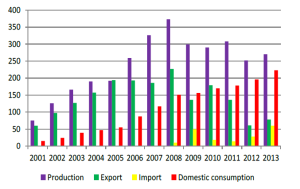
Finland is an important producer country on the European wood pellet market. Despite the intensive development of wind and solar power, forest biomass remains the most significant energy source in the country. Therefore, an in depth understanding of the local pellet business plays a crucial role in local market development and utilisation of bio energy in the country and in turn the international trade. The researchers from Lappeenranta University of Technology and Mikkeli Development Miksei Ltd, Finland have conducted a detailed study in this regard.
Current status of the Finnish pood pellet sector
Vapo Oy, a partly state owned publicly unlisted company, is the leading producer of wood pellets in Finland. The factories have a combined production capacity of approximately 250,000 tons. In 2013, Finnish wood pellet consumption was slightly over 220,000 tons. Local demand grew to 270,000 tons the following year, which is more than 80% of total domestic production. In 2015, local demand is expected to reach 330,000 tons. Approximately, 23,000 Finnish single family houses are heated with pellets. The tests from co-combustion of wood pellets with coal indicate the possibility of burning 5-7% of wood pellets in coal based fuel without having to make major modifications to the burners. However, the Finnish pellet market remains export oriented and the domestic consumption accounts for a relatively small share of total production. Finnish exports of wood pellets have changed over the period 2005-2013, although not as significantly as wood pellet production . However, recent years show that consumption is increasing especially for district heat, and it is possible to envisage changes in the export/import balance. The export of Finnish wood pellets plays a crucial role in EU wood pellet market. Finland exports wood pellets to the EU, while imports come from Russia.
The government policy has been supporting bioenergy through various means such as R&D grants, investment grants and energy and environmental taxes. According the Finnish National Renewable Energy Action Plan(NREAP),small scale CHP plants that use wood fuel can receive support via a feed in tariff. Investments related to the use of pellets in renovated buildings will be subsidized with investment grants.
A promising future
In view of the target of increasing biomass consumption, availability of forest resources and development of new technology, the future of the wood pellet industry in Finland seems promising. Several power plants have started, expressed interest in beginning to use or increasing existing usage of wood pellets. The construction of new pellet plants or enlargement of existing plants will be the central part of development of the Finnish energy sector.
Read more. This posts is based on the paper by Proskurina et. al. “The Wood Pellet Business in Finland“, presented at the 23rd European Biomass Conference and Exhibition.


